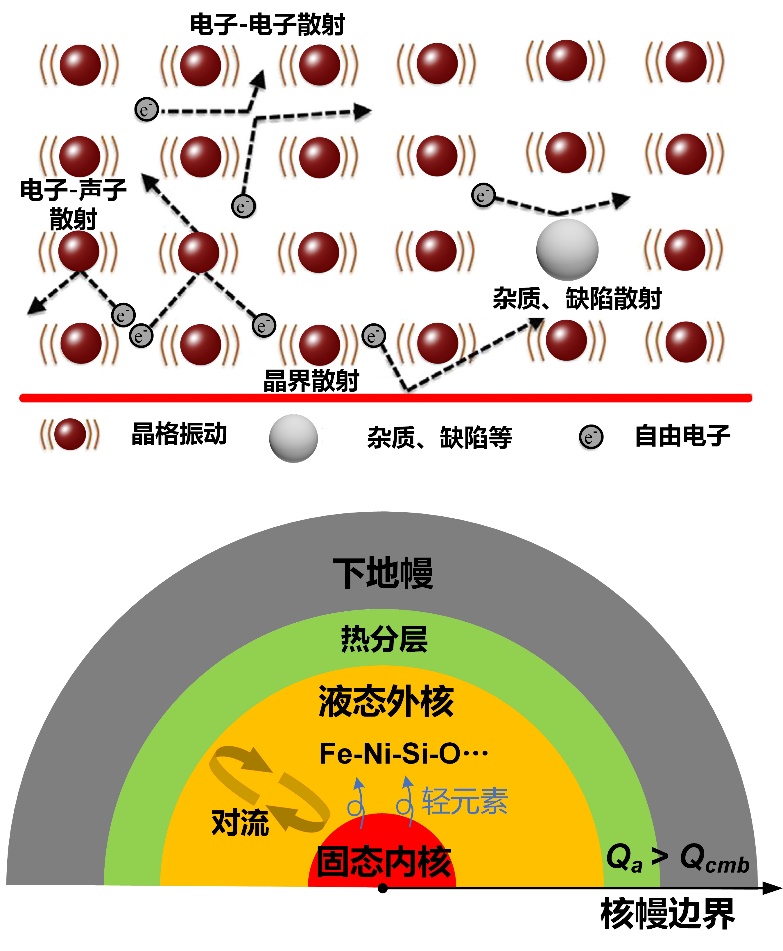In collaboration with theAcademy for Precision Measurement Science and Technology, Chinese Academy of Sciences,Carnegie Institution for Science, the University of Illinois and the University of Texas at Austin, Youjun Zhang of the Institute of Atomic and Molecular Physics, Sichuan University, has published a research paper entitled "Thermal Conductivity of Fe Si Alloys and Thermal Stratification in Earth's Core” in Proc. Natl. Acad. Sci. U.S.A. (Proceedings of the National Academy of Sciences of the United States of America). This paper reveals the physical properties of electrothermal transport of earth core components under relevant conditions, and establishes the dynamic model of earth core, making an important breakthrough in the field of Physics of Earth’s Interior.
The center of the earth is about 3,000 kilometers below our feet.“Earth’s liquid outer core is mainly composed of iron alloyed with∼8 to 10% of light elements (e.g., silicon). Convection of the liquid core generates Earth’s magnetic field, which is controlled by the thermal conductivity of the core. In this study, we investigated the resistivity and thermal conductivity of iron-silicon alloys as a candidate composition in Earth’s core via high-pressure and -temperature experiments and numerical calculations. We found a near temperature independence of the resistivity in iron-silicon alloys at Earth core’s pressure and thus a high thermal conductivity. This work indicates that if silicon is the sole major light element in Earth’s core it could depress thermal convection and promote a thermally stratified layer at the topmost outer core.” (Significance)
“Light elements in Earth’s core play a key role in driving convection and influencing geodynamics, both of which are crucial to the geodynamo. However, the thermal transport properties of iron alloys at high-pressure and -temperature conditions remain uncertain. Here we investigate the transport properties of solid hexagonal close-packed and liquid Fe-Si alloys with 4.3 and 9.0 wt % Si at high pressure and temperature using laser-heated diamond anvil cell experiments and first-principles molecular dynamics and dynamical mean field theory calculations.--- Our results show a thermal conductivity of∼100 to 110 W⋅m−1⋅K−1for liquid Fe-9Si near the topmost outer core. If Earth’s core consists of a large amount of silicon (e.g., > 4.3 wt %) with such a high thermal conductivity, a subadiabatic heat flow across the core–mantle boundary is likely, leaving a 400- to 500-km-deep thermally stratified layer below the core–mantle boundary, and challenges proposed thermal convection in Fe-Si liquid outer core.” (Abstract)

Fig. Microscopic scattering mechanism of ferroalloy transport properties under extreme conditions (above)
and schematic diagram of thermal stratification and convection in the earth core (below)
The research paper was published in Proc. Natl. Acad. Sci. U.S.A. on Jan.4, 2022. Youjun Zhang of the College of Physics is the co first author, and the Institute of Atomic and Molecular Physics of Sichuan University is the first work unit. This is a new achievement the research team has made since 2020 when they published a paper in Phys. Rev. Lett. (125, 078501).This work was supported by the National Natural Science Foundation of China (42074098 and 41804082), Sichuan University and so forth.
https://www.pnas.org/content/119/1/e2119001119
